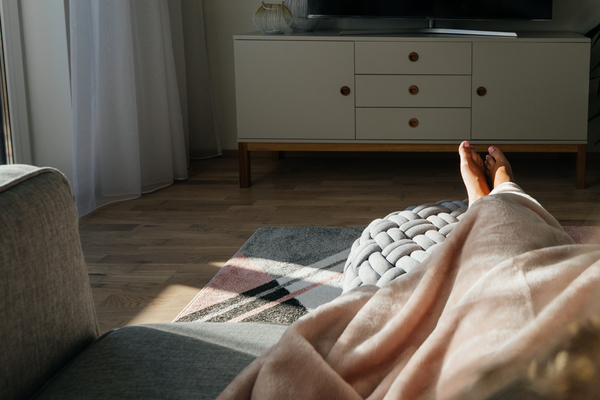Sustainable data centers as a service
COVID-19 has blurred the boundaries between home life and working life in a way that can feel unpleasant at times.

Many remote meetings during the COVID-19 pandemic have started with the same types of comments.
“Oh dear, what can you see behind me?” I need to make sure the cabinet doors are closed. Wait, just let me see if I remembered to clean this table…”
And so on.
People who work from home are worried about what their colleagues can see through the lens of the camera.
We can all laugh at this phenomenon – after all, we can relate to the feeling of being unsure about what your home says about you. Or, to be more precise: what does your home say about you that you’d rather keep to yourself?
Later, I go online, type “home shame” in the search engine and find out that this is a real phenomenon that several articles have been written about.
Home shame keeps people from inviting their friends over
As many as one in five Finns feel home shame all the time or often according to Talouselämä (8 September 2020). In the same survey, 49 per cent of the respondents said they feel home shame at least sometimes.
A Bachelor’s Thesis in Arts* written by a student at Aalto University describes home shame as the feeling of not wanting to invite friends over when you have dirty dishes in the kitchen sink or a pile of laundry on the sofa.
“To put it briefly, home shame is the feeling of stress that comes from believing that your home should always be in tip-top shape. It’s a form of anxiety that turns normal life into an endless process of cleaning and organising. Home shame keeps people from inviting their friends over and opening the door for unexpected visitors. It makes us become firmly entrenched in our homes, leave visitors outside of our lives and curl up alone in the incompleteness of the home,” the introduction to the Bachelor’s Thesis says.
The study also references Ilana Aalto, a researcher in the field of cultural history and a professional organiser, who has described home shame as “the fear of other people not accepting or loving us unless we constantly maintain a facade of decency”.
I flinch. That doesn’t sound like a nice feeling to have. I would never (at least knowingly) think badly of my colleagues based on what their home looks like. Instead, I identify with the feeling of joy I get from getting to take a look inside their home and seeing a different side of them. Or, I should say that I did, before that blurring tool became a thing.
I decide to call Ilana Aalto, as she’s someone I’ve previously met through my work, to ask more about this phenomenon that I’ve become aware of due to the COVID-19 pandemic and the increase in remote work. My interest in the topic is both personal and professional – after all, YIT is in the business of building homes.

It’s easier to act professional when your home is not visible in the background
“The COVID-19 pandemic forces us to blend our working life and home life in a completely new way that is unpleasant to some people,” Aalto says, adding that she carefully chooses the location of her workstation at home based on what is visible in the background. “It’s easier to act professional when the view behind you is something you’re comfortable with – especially if you are a professional organiser by trade,” Aalto explains.
Ilana Aalto suspects that home shame is related to a change in the culture of visiting people’s homes – which has been declining for about 40 years now. People and their homes have become very private despite the fact that social media exposes us to more photos of each other’s homes than ever before.
Of course, people’s homes always look great in the photos.
“Visiting people and having people come over to your house doesn’t really call for absolute tidiness. What it really calls for is time. Perhaps it’s not so much shame that keeps people from visiting each other. It might just be that people have less time in their daily lives.”
Aalto suspects that home shame is more of a problem for women than men. This is reflected in the fact that most of the customers who attend Aalto’s online courses are women.
“The people who are especially prone to feeling home shame are probably performance-oriented and they have a tendency to want to please others. The society around us sends strong messages that you’re a better person if your home is tidy. In a way, it’s similar to the discussion around managing your weight and staying slim,” Aalto points out. “You need to be tough to ignore those messages.”

The roots of shame go deep into our history
Home shame – and the reason it afflicts women in particular – could also be seen as having historical causes. Aalto cites the example of the book Transformations of the Dwelling: Gender and the Aesthetics of Cleanliness in Modern Architecture by Kirsi Saarikangas, which discusses the foundations established in the 1920s–1950s for today’s family apartments and the standards concerning cleanliness and health.
“The home was seen as the foundation for raising your children well. That, in turn, has traditionally been viewed primarily as women’s responsibility.”
The same theme was addressed by the researcher Mona Mannevuo recently in an interview in Helsingin Sanomat, in which she noted that the expectations concerning the home haven’t emerged from nothing. You might feel differently about doing your chores if you recognise that the ideals concerning cleanliness are – at least in part – originally related to the fight against tuberculosis.
Ilana Aalto encourages people to think about their ideals and feelings of shame related to the home. That is especially important if they feel that those feelings make them miss opportunities to do things or restrict their lives because of the feeling of shame.
“I know people who start cleaning at least three weeks before they host a party or redecorate their entire home before inviting guests for a special occasion. It’s no wonder that there’s such a high threshold for people to throw a party! It’s particularly regrettable if the shame felt by the adult members of the family prevent the children from inviting their friends over. That restricts their social life.”
I personally don’t feel home shame with regard to tidiness and interior decoration, but I’m such a bad cook that I hesitate to invite anyone over for a meal. The food I serve wouldn’t look great on Instagram at least.
“Maybe my guests would be happy with a bag of crisps and some dip?” Or maybe I should do a potluck instead. Meeting people is more important than the setting in which you meet them,” Aalto concludes.
The author works in YIT’s Group Communications.
*Veera Hakomäki, Aalto University 2019, From home shame to home positivity – how an interior architect can promote aesthetic well-being



